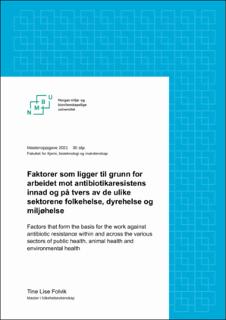| dc.contributor.advisor | Bukholm, Geir | |
| dc.contributor.advisor | Littmann, Jasper Rick | |
| dc.contributor.author | Folvik, Tine Lise Overud | |
| dc.date.accessioned | 2021-11-02T14:47:08Z | |
| dc.date.available | 2021-11-02T14:47:08Z | |
| dc.date.issued | 2021 | |
| dc.identifier.uri | https://hdl.handle.net/11250/2827349 | |
| dc.description.abstract | Bakgrunn: Det har skjedd en dramatisk økning av antibiotikaresistente mikrober innenfor nesten alle økologiske nisjer de siste tiårene og i 2012 slo WHO fast at antibiotikaresistens er en av de største helsetruslene i verden. Den globale handlingsplanen mot antibiotikaresistens legger vekt på at det er en sterk sammenheng mellom humanhelse, dyrehelse og miljø og anbefaler at disse sektorene bør ha fokus på en én-helse tilnærming. WHO presiseres også i den globale handlingsplanen at alle land oppfordres til å utarbeide nasjonale handlingsplaner mot antimikrobiell resistens.
Formål: Nasjonal strategi mot antibiotikaresistens 2015-2020 angir mål og tiltaksområder knyttet til antimikrobiell resistens. Dette er en felles overordnet strategi innenfor humanhelse, matproduserende landdyr og kjæledyr, fisk og klima og miljø. Formålet med denne studien er å få et innblikk i hvilke faktorer som ligger til grunn for arbeidet mot antibiotikaresistens innad og på tvers av de ulike sektorene folkehelse, dyrehelse og miljøhelse i Norge.
Metode: Det er gjennomført en kvalitativ multippel casestudie. Det ble gjennomført fire besøksintervjuer og ett telefonintervju. Informantene er personer som jobber med det nasjonale arbeidet mot antibiotikaresistens på seniornivå innenfor Helse- og Omsorgsdepartementet, Folkehelseinstituttet, Mattilsynet, Veterinærinstituttet og et Referanselaboratorium. Det ble brukt tematisk analyse for å analysere resultatene.
Resultater: Norge har lite antibiotika bruk og lav prevalens av AMR i forhold til andre land og mye av arbeidet innenfor hver sektor går ut på å holde det på et lavt nivå. Informantene mener det at Norge er et lite land gjør det enklere å samarbeide da det er færre folk som jobber med AMR og det er lettere å ha et godt nettverk og vite hvem man skal kontakte når. Informantene mener at det er et godt samarbeidet på tvers av sektorene, spesielt innenfor humanhelse og dyrehelse, miljøsiden er i mindre grad involvert i dette samarbeidet.
Oppsummering: Informantene mener vi har en god situasjon med tanke på AMR i Norge, funnene indikerer at reise og import av AMR er en av de største utfordringene her i landet. Det er en enighet blant informantene at politikkutformingen og beslutningene som gjøres knyttet til AMR i alle sektorer er kunnskapsbaserte og lite påvirket av andre faktorer. Informantene oppfatter én-helse tilnærmingen som tilstedeværende i arbeidet mot AMR, men det er noe uenighet om i hvilken grad AMR bør ha et én-helse perspektiv. Det kreves mer forskning på den eventuelle påvirkningen miljøet har på utviklingen og spredningen av AMR. | en_US |
| dc.description.abstract | Background: There has been a dramatic increase in antibiotic-resistant microbes (AMR) within almost all ecological niches over the past decades. WHO stated in 2012 that antibiotic resistance is one of the biggest treats to the human health. The Global Action Plan Against Antibiotic Resistance emphasizes a strong link between human-, animal- and environmental health and recommends these sectors to focus on a One-health approach. The Global Action Plan encourage all countries to have in place national action plans against AMR.
Objective: The National Strategy against Antibiotic Resistance 2015-2020 sets out goals and focus areas related to AMR. This is a common overall strategy within human health, food producing animals and household pets, fish and climate and environment. The purpose of this study is to gain an insight of the factors that form the basis for the work against AMR within the various sectors of public health, animal health and environmental health in Norway.
Methods: A qualitative multiple case study has been conducted with four visitor interviews and one telephone interview. The informants work within the national work against antibiotic resistance at senior level within the Ministry of Health and Care Services, the Norwegian Institute of Public Health, The Norwegian Food Safety Authority, The Veterinary Institute and a Reference Laboratory. Thematic analysis was used to analyze the results.
Results: Norway has low consumption and low prevalence of AMR compared to other countries and much of the work within each sector it about keeping it at a low level. The informants believe that because Norway is a small country makes it easier to collaborate as there are fewer people working with AMR and it is easier to have a good network and know who to contact when. The informants thinks that there is good collaboration across sectors, especially within human health and animal health, the environment is to a lesser extent involved in this collaboration.
Summary: The informants believe we have a good situation regarding AMR in Norway, the findings indicate that travel and import of AMR is one of the biggest challenges in this country. There is an agreement among the informants that policymaking and policyadvice associated with AMR in all sectors are knowledge-based and little influenced by other factors. The informants perceive the One-health approach as present in the fight against AMR, but there is some disagreement about the extent to which AMR should have a One-health approach. More research is needed on the possible impact the environment has on the development and spread of AMR. | |
| dc.language.iso | nob | en_US |
| dc.publisher | Norwegian University of Life Sciences, Ås | en_US |
| dc.rights | Attribution-NonCommercial-NoDerivatives 4.0 Internasjonal | * |
| dc.rights.uri | http://creativecommons.org/licenses/by-nc-nd/4.0/deed.no | * |
| dc.title | Faktorer som ligger til grunn for arbeidet mot antibiotikaresistens innad og på tvers av de ulike sektorene folkehelse, dyrehelse og miljøhelse | en_US |
| dc.title.alternative | Factors that form the basis for the work against antibiotic resistance within and across the various sectors of public health, animal health and environmental health | en_US |
| dc.type | Master thesis | en_US |
| dc.description.localcode | M-FOL | en_US |

